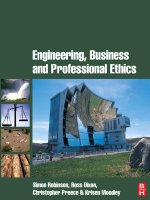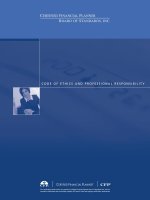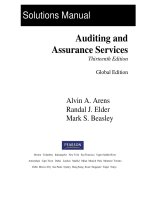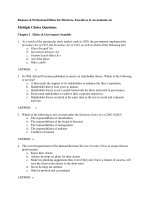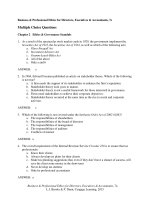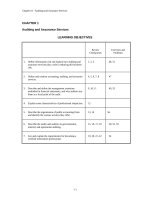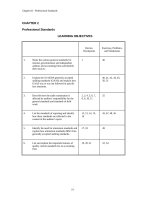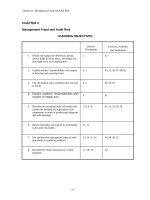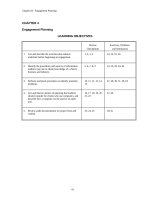Advanced auditing and professional ethics practice manual ICAI
Bạn đang xem bản rút gọn của tài liệu. Xem và tải ngay bản đầy đủ của tài liệu tại đây (2.65 MB, 332 trang )
PRACTICE MANUAL
PAPER : 3
ADVANCED AUDITING AND
PROFESSIONAL ETHICS
BOARD OF STUDIES
THE INSTITUTE OF CHARTERED ACCOUNTANTS OF INDIA
i
This practice manual has been prepared by the faculty of the Board of Studies. The
objective of the practice manual is to provide teaching material to the students to enable
them to obtain knowledge and skills in the subject. In case students need any
clarifications or have any suggestions to make for further improvement of the material
contained herein, they may write to the Director of Studies.
All care has been taken to provide interpretations and discussions in a manner useful for
the students. However, the practice manual has not been specifically discussed by the
Council of the Institute or any of its Committees and the views expressed herein may not
be taken to necessarily represent the views of the Council or any of its Committees.
Permission of the Institute is essential for reproduction of any portion of this material.
© THE INSTITUTE OF CHARTERED ACCOUNTANTS OF INDIA
All rights reserved. No part of this book may be reproduced, stored in retrieval system, or
transmitted, in any form, or by any means, electronic, mechanical, photocopying, recording, or
otherwise, without prior permission in writing from the publisher.
Edition
:
January, 2015
Website
:
www.icai.org
:
Committee /
Department
:
Board of Studies
ISBN No.
:
Price
:
`
Published by
:
The Publication Department on behalf of The Institute of Chartered
Accountants of India, ICAI Bhawan, Post Box No. 7100,
Indraprastha Marg, New Delhi – 110 002
Printed by
:
Sahitya Bhawan Publications, Hospital Road, Agra 282 003
ii
A WORD ABOUT PRACTICE MANUAL
The Board of Studies has been instrumental in imparting theoretical education for the students
of Chartered Accountancy Course. The distinctive characteristics of the course i.e., distance
education, has emphasized the need for bridging the gap between the students and the
Institute and for this purpose, the Board of Studiers has been providing a variety of
educational inputs for the students. Bringing out a series of subject-wise Practice Manuals is
one of the quality services provided by the Institute. These Practice Manuals are highly useful
to the students preparing for the examinations, since they are able to get answers for all
important questions relating to a subject at one place and that too, grouped chapter-wise. It
covers a wide range of practical questions and questions based on practical application of
Statements, Standards on Auditing, Guidance Notes, Accounting Standards, relevant
provisions of the Companies Act, 2013, Code of Ethics, Clause 49 and Corporate
Governance, Peer Review, Audit of Banking Companies, Insurance Companies, NBFCs etc.
The students are expected to cover the entire syllabus and also do the practice on their own
while going through the Practice Manual. The main aim of this Practice Manual is to provide
guidance as to the manner of writing answers in the examination.
Enhanced role of the auditors has also been perceived at home in the context of implementing
code of corporate governance and various fiscal legislations. “Advanced Auditing and
Professional Ethics” paper in the Final Course concentrates on understanding of the crucial
aspects of audit of financial statements. Standardization of accounting and auditing policies
and financial reporting norms are significant aspects that make the subject more interesting in
the recent years.
The Practice Manual in the subject of “Advanced Auditing and Professional Ethics” is divided
into twenty two chapters. Care has been taken to present the chapters in the same sequence
as prescribed in the syllabus to facilitate easy understanding by the students. The students
are expected to cover the entire syllabus and also do the practice on their own while going
through the Practice Manual. Brief summary of Engagement and Quality Control Standards
and clauses of Professional Ethics are being added in this edition. The main aim of this
Practice Manual is to provide guidance as to the manner of writing answers in the
examination. The main feature of this Practice Manual is compilation of good questions from
the previous examinations.
The Practice Manual will serve as a useful and handy reference guide while preparing for Final
Examination. Further, it will enhance the understanding about the pattern of questions set and
the manner of answering such questions. It will enable solving the problems in the best
possible manner and guide the students to improve their performance in the examinations. It
iii
will also help them to work upon their grey areas and plan a strategy to tackle theoretical as
well as practical problems.
This Volume II i.e. Practice Manual has been revised in view of revised Standards on Auditing,
Notified Sections along with its relevant Rules, significant Notification/Circulars issued by MCA
inclusive of the Companies Act, 2013 and Schedule III, Tax Audit Form 3CA, 3CB and 3CD
revised on 25th July, 2014, Revised Clause 49 etc. The changes have been inserted in the
bold and italics for convenience of the students.
It is important to note that till the time Statements, Engagement and Quality Control
Standards, Guidance Notes, Code of Ethics etc. bare documents get updated from Auditing
and Assurance Standard Board, Ethical Standard Board of ICAI and other Competent
Authority in pursuance of the Companies Act, 2013, students are required to understand the
basic nature of the provision and quote the same along with the new corresponding
provisions.
Finally, we would welcome suggestions to make this book more helpful and ‘student-friendly’.
In case of any doubt, students are welcome to write through e-Sahaayataa, Grievance
Redressal System of the ICAI.
Happy Reading and Best Wishes!
iv
Liabilities of
Auditors
7.
6.
5.
4.
3.
2.
Auditing
1(a)
Standards,
1(b)
Statements 1(c)
and
1(d)
Guidance
8(a)
Notes – an
Overview
5(c)
Audit
6(b)
Strategy,
Planning and
Programmin
g
Risk
Assessment
And Internal
Control
Audit Under
Computerise
d Information
System (CIS)
Environment
Special Audit
Techniques
4(a)
The
Company
Audit
8
6
8
5
5
4
4
8
6 (b)
6 (a)
5 (a)
6(c)
1(a)
1(b)
1(c)
1(d)
3 (a)(i)
4 (c)
4
8
8
4
4
6
5
5
5
5
5(d)
3(b)
5(c)
1(c)
3(d)
5(b)
3(a)
1(a)
1(d)
3(c)
5
4
3
5
4
4
4
5
5
4
3(a)
4(a)
3(c)
6(c)
3(b)
1(a)
1(b)
1(c)
1(d)
7(c)
4
6
8
5
4
5
5
5
5
4
4 (b)
4 (c)
1(a)
1(b)
1(c)
1(d)
3 (b)
4 (a)
7 (e)
3 (a)
8
4
4
4
6
6
8
4
4
8
6 (c)
6 (a)
6 (d)
4 (a)
1(a)
1(b)
1(c)
1(d)
3 (c)
6 (b)
5
3
6
8
5
5
5
5
6
2
v
6
4
7 (e)
20
8
6
6 (a)
1
4 (a)
6 (c)
June, 2009 November, May, 2010 November, May, 2011 November, May, 2012
2009
2010
2011
Q
M Q
M Q M Q M
Q M Q
M
Q
M
1.
Syllabus
contents
1 (c)
3 (b)
4 (a)
1(a)
1(b)
1(d)
3(a)
5 (b)
5
8
8
5
5
5
8
8
1(a)
1(b)
1(c)
1(d)
5(c)
5(d)
3(a)
3(b)
3(c)
3(d)
7(c)
November, May, 2013
2012
Q
M
Q
M
5
5
5
5
4
4
4
4
4
4
4
5(c)
3(c)
6(a)
1(a)
3(a)
5(a)
3(b)
4(d)
1(b)
1(d)
2(c)
2(d)
November,
2013
Q
M
Group I : Paper 3 Advanced Auditing and Professional Ethics
Statement showing Topic-wise distribution of Examination Questions along with Marks
4
4
4
5
4
4
4
4
5
5
4
4
5
5
5
5
4
4
3(d) 4
3(a) 4
3(c) 4
7(b) 4
7(d) 4
1(a)
1(b)
1(c)
1(d)
7(c)
7(e)
May,
2014
Q M
13
89
19
51
46
38
297
Total
Marks
1.18
8.09
1.73
4.64
4.18
3.45
27
Average
Audit
Committee
And
Corporate
Governance
Audit
of
Consolidated
Financial
Statements
Audit
of
Banks
Audit
of
General
Insurance
Companies
Audit of Cooperative
Societies
Audit of Non
Banking
Financial
Companies
Audit under
Fiscal Laws
9.
3 (b)
3 (c)
5 (b)
5
3
4
6(c)
6(b)
Assignments
of
18. Audit
Public Sector
Undertakings
4
8
7(b)
6(a)
4(a)
4(b)
4(c)
17. Special Audit 8(b)(i)
8
7(a)
4
5
4 (b)
5 (c)
5
4 (a)
1(b)
5(a)
8
8
8
5
6(a)
4(b)
3(b)
5(b)
16. Cost Audit
15.
14.
13.
12.
11.
10.
Audit Report
8.
4
4
5
4
6
4
6
5
7(a)
7(e)
5(b)
5(a)
7(d)
7(b)
4(b)
4(c)
6(a)
4
4
5
6
4
4
5
5
6
7 (c)
7 (b)
7 (a)
6 (c)
6 (b)
6 (a)
5
4
4
4
4
4
8
16
3 (b)
7 (a)
7 (d)
4 (b)
5 (a)
7 (c)
5 (b)
3 (a)
5 (c)
7 (e)
5
4
4
8
7
4
5
5
4
4
vi
7 (a)
7 (c)
7 (b)
3 (b)
7 (d)
3 (a)
6 (b)
5 (c)
4
4
4
6
4
10
4
8
7 (c)
7 (d)
7 (b)
7 (e)
6 (b)
6 (c)
7 (a)
4 (b)
5 (a)
4
4
4
4
4
6
4
8
8
7(e)
4(c)
7(a)
4(a)(i)
4(a)(ii)
4(b)
7(d)
6(a)
6(b)
6(c)
4
4
4
5
3
4
4
4
8
4
7(e)
7(b)
6(c)
7(d)
4(c)
4(b)
4(a)
6(d)
7(c)
1(c)
5(d)
4
4
4
4
4
4
4
4
4
5
4
6(a) 6
5(c) 5
7(a) 4
5(b) 6
5(a) 5
4(c) 6
3(b) 4
4(a) 4
4(b) 6
22
54
16
67
22
30
41
59
26
16
122
2
4.91
1.45
6.09
2
2.73
3.73
5.36
2.36
1.45
11.09
3(a)
8
Audit,
Management
and
Operational
Audit
20. Investigation
s and Due
Diligence
21. Peer Review 8(b)(ii) 4 3(a)(ii) 4
18
2
16
22. Professional 2
Ethics
5(a)
5
6(d)
2
3
16
16
5
5(c)
2
5
6(b)
2
7 (d)
16
4
7 (b)
2
4
16
5 (a)
2
4 (b)
5 (b)
4
16
8
4
2
6 (a)
16
8
7(b)
2(a)
2(b)
2(c)
2(d)
5(a)
5(b)
4
4
4
4
4
4
4
7(a)
2(a)
2(b)
3(d)
6(b)
5(b)
4
4
4
4
4
4
6(d)
2(a)
2(b)
2(c)
2(d)
3
4
4
4
4
6(c) 4
6(b) 3
30
183
33
28
2.73
16.64
3
2.55
vii
Note:’ Q’ represents question numbers as they appeared in the question paper of respective examination. ‘M’ represents the marks which each question carried in
that examination. The question papers of all the past attempts of Final Examination can be accessed from the BOS Knowledge Portal on the Institute website
www.icai.org.
19. Internal
CONTENTS
CHAPTER 1 –
AUDITING STANDARDS, STATEMENTS AND GUIDANCE
NOTES – AN OVERVIEW ...................................................... 1.1 – 1.76
CHAPTER 2 –
AUDIT STRATEGY, PLANNING AND PROGRAMMING .......... 2.1 – 2.18
CHAPTER 3 –
RISK ASSESSMENT AND INTERNAL CONTROL ................... 3.1 – 3.12
CHAPTER 4 –
AUDIT UNDER COMPUTERISED INFORMATION SYSTEM (CIS)
ENVIRONMENT ..................................................................... 4.1 – 4.18
CHAPTER 5 –
SPECIAL AUDIT TECHNIQUES ............................................... 5.1 – 5.8
CHAPTER 6 –
THE COMPANY AUDIT .......................................................... 6.1 – 6.41
CHAPTER 7 –
LIABILITIES OF AUDITORS .................................................... 7.1 – 7.8
CHAPTER 8 –
AUDIT REPORT .................................................................... 8.1 – 8.17
CHAPTER 9 –
AUDIT COMMITTEE AND CORPORATE GOVERNANCE ........ 9.1 – 9.6
CHAPTER 10 – AUDIT OF CONSOLIDATED FINANCIAL STATEMENTS ...... 10.1 – 10.4
CHAPTER 11 – AUDIT OF BANKS ............................................................. 11.1 – 11.23
CHAPTER 12 – AUDIT OF GENERAL INSURANCE COMPANIES ................. 12.1–12.12
CHAPTER 13 – AUDIT OF CO-OPERATIVE SOCIETIES ............................... 13.1 – 13.9
CHAPTER 14 – AUDIT OF NON BANKING FINANCIAL COMPANIES ........... 14.1 – 14.8
CHAPTER 15 – AUDIT UNDER FISCAL LAWS ........................................... 15.1 – 15.20
CHAPTER 16 – COST AUDIT ....................................................................... 16.1 – 16.6
CHAPTER 17 – SPECIAL AUDIT ASSIGNMENTS ...................................... 17.1 – 17.12
CHAPTER 18 – AUDIT OF PUBLIC SECTOR UNDERTAKINGS .................... 18.1 – 18.6
CHAPTER 19 – INTERNAL AUDIT, MANAGEMENT AND OPERATIONAL
AUDIT ............................................................................... 19.1 – 19.18
CHAPTER 20 – INVESTIGATION AND DUE DILIGENCE ............................ 20.1 – 20.27
CHAPTER 21 – PEER REVIEW .................................................................... 21.1 – 21.7
CHAPTER 22 – PROFESSIONAL ETHICS .................................................. 22.1 – 22.56
viii
ix
1
Auditing Standards, Statements and
Guidance Notes – An Overview
The Council of the ICAI has issued following Quality Control and Engagement
Standards
S.
No.
1
No. of
Standard
SQC 1
2
SA 200
3
4
SA 210
SA 220
5
6
SA 230
SA 240
7
SA 250
8
SA 260
9
SA 265
10
11
12
SA 299
SA 300
SA 315
13
14
15
SA 320
SA 330
SA 402
Title of the Standard
Quality Control for Firms that Perform Audits
and Reviews of Historical Financial Information,
and Other Assurance and Related Services
Engagements
Overall Objectives of the Independent Auditor
and the Conduct of an Audit in Accordance with
Standards on Auditing
Agreeing the Terms of Audit Engagements
Quality Control for an Audit of Financial
Statements
Audit Documentation
The Auditor’s responsibilities Relating to Fraud
in an Audit of Financial Statements
Consideration of Laws and Regulations in an
Audit of Financial Statements
Communication with Those Charged with
Governance
Communicating Deficiencies in Internal Control
to Those Charged with Governance and
Management
Responsibility of Joint Auditors
Planning an Audit of Financial Statements
Identifying and Assessing the Risks of Material
Misstatement through Understanding the Entity
and its Environment
Materiality in Planning and Performing an Audit
The Auditor’s Responses to Assessed Risks
Audit Considerations Relating to an Entity Using
© The Institute of Chartered Accountants of India
*Effective
Date
April 1, 2009
April 1, 2010
April 1, 2010
April 1, 2010
April 1, 2009
April 1, 2009
April 1, 2009
April 1, 2009
April 1, 2010
April 1, 1996
April 1, 2008
April 1, 2008
April 1, 2010
April 1, 2008
April 1, 2010
16
SA 450
17
18
SA 500
SA 501
19
20
21
22
23
SA 505
SA 510
SA 520
SA 530
SA 540
24
25
26
27
28
29
30
31
SA 550
SA 560
SA 570
SA 580
SA 600
SA 610
SA 620
SA 700**
32
SA 705**
33
SA 706**
34
SA 710
35
SA 720
36
SA 800
37
SA 805
38
SA 810
39
SRE 2400
a Service Organization
Evaluation of Misstatements Identified during
the Audits
Audit Evidence
Audit Evidence - Specific Considerations for
Selected Items
External Confirmations
Initial Audit Engagements-Opening Balances
Analytical Procedures
Audit Sampling
Auditing Accounting Estimates, Including Fair
Value Accounting Estimates, and Related
Disclosures
Related Parties
Subsequent Events
Going Concern
Written Representations
Using the Work of Another Auditor
Using the Work of Internal Auditors
Using the Work of an Auditor’s Expert
Forming an Opinion and Reporting on Financial
Statements
Modifications to the Opinion in the Independent
Auditor’s Report
Emphasis of Matter Paragraphs and Other
Matter Paragraphs in the Independent Auditor’s
Report
Comparative Information – Corresponding
Figures and Comparative Financial Statements
The Auditor’s Responsibility in Relation to Other
Information in Documents Containing Audited
Financial Statements
Special Considerations-Audits of Financial
Statements Prepared in Accordance with
Special Purpose Framework
Special Considerations-Audits of Single
Purpose Financial Statements and Specific
Elements, Accounts or Items of a Financial
Statement
Engagements to Report on Summary Financial
Statements
Engagements to Review Financial Statements
© The Institute of Chartered Accountants of India
April 1, 2010
April 1, 2009
April 1, 2010
April 1, 2010
April 1, 2010
April 1, 2010
April 1, 2009
April 1, 2009
April 1, 2010
April 1, 2009
April 1, 2009
April 1, 2009
April 1, 2002
April 1, 2010
April1, 2010
April 1, 2011
April 1, 2011
April 1, 2011
April 1, 2011
April 1, 2010
April 1, 2011
April 1, 2011
April 1, 2011
April 1, 2010
40
SRE 2410
41
SAE 3400
42
SAE 3402
43
SRS 4400
44
SRS 4410
Review of Interim Financial Information
Performed by the Independent Auditor of the
Entity
The Examination of Prospective Financial
Information
Assurance Reports on Controls At a Service
Organisation
April 1, 2010
Engagements to Perform Agreed Upon
Procedures Regarding Financial Information
Engagements to Compile Financial Information
April 1, 2004
April 1, 2007
April 1, 2011
April 1, 2004
*
Effective date means that the SA is effective for audits of the financial statements
for periods beginning on or after the specified date.
**
“The Council, in partial modification of the decision taken by it at its 291st meeting
held in December, 2009, decided that the effective date/applicability of the
following Standards on Auditing a) SA 700 (Revised), “Forming an Opinion and
Reporting on Financial Statements”;b) SA 705, “Modifications to the Opinion in
the Independent Auditor’s Report”;c) SA 706, “Emphasis of Matter Paragraphs and
Other Matter Paragraphs in the Independent Auditor’s Report” be postponed by
one year and consequently the said Standards shall now be effective/applicable for
audits of financial statements for periods beginning on or after 1st April, 2012
(instead of audits of financial statements for periods beginning on or after
1st April, 2011 as was earlier decided and referred to above).
1.1 A brief summary of each Standard issued by AASB is given below:
1.1.1 Standard on Quality Control (SQC) 1, “Quality Control for Firms that Perform Audits
and Reviews of Historical Financial Information, and Other Assurance and Related Services
Engagements”.
It is a mother Standard for all other Standards and is all pervasive Standard in respect of
quality control. As the name suggests, the SQC 1 contains extensive requirements in
relation to establishment and maintenance of a system of quality control (QC) in the audit
firms as well as even for sole practitioners. The important elements of a system of quality
control discussed by the Standard include Elements of a System of Quality Control,
Leadership Responsibilities for Quality Within the Firm, Ethical Requirements –
Independence, Acceptance and Continuation of Client Relationships and Specific
Engagements, Human Resources - Assignment of Engagement Team, Engagement
Performance - Consultation, Differences of Opinion, Engagement Quality Control Review
and Documentation of the Engagement Quality Control Review - Engagement
Documentation.
The Standard is recommendatory from April 1, 2008 and mandatory from April 1, 2009.
© The Institute of Chartered Accountants of India
1.1.2 SA 200: Overall Objectives of the Independent Auditor and the Conduct of an Audit in
Accordance with Standards on Auditing-it establishes the independent auditor’s overall
responsibilities when conducting an audit of financial statements in accordance with SAs.
Specifically, it sets out the overall objectives of the independent auditor, and explains the
nature and scope of an audit designed to enable the independent auditor to meet those
objectives. It also explains the scope, authority and structure of the SAs, and includes
requirements establishing the general responsibilities of the independent auditor applicable
in all audits, including the obligation to comply with the SAs. It has to be adapted as
necessary in the circumstances when applied to audits of other historical financial
information. This SA requires that the auditor to obtain reasonable assurance about
whether the financial statements as a whole are free from material misstatement, whether
due to fraud or error.
The SAs require that the auditor exercise professional judgment and maintain professional
skepticism throughout the planning and performance of the audit and, among other things:
•
Identify and assess risks of material misstatement, whether due to fraud or error,
based on an understanding of the entity and its environment, including the entity’s
internal control (further expounded in SA 315 and SA 330).
•
Obtain sufficient appropriate audit evidence about whether material misstatements
exist, through designing and implementing appropriate responses to the assessed
risks (further expounded in SA 500 and SA 501).
•
Form an opinion on the financial statements based on conclusions drawn from the
audit evidence obtained (further expounded in SA 700, SA 705, SA 706 and SA 720).
This SA is effective for audits of financial statements for periods beginning on or after
April 1, 2010.
1.1.3 SA 210: Agreeing the Terms of Audit Engagements- It is a revised version of the
erstwhile Auditing and Assurance Standard (AAS) 26, “Terms of Audit Engagements”
issued by the Institute in 2003. The revised Standard deals with the auditor’s
responsibilities in agreeing the terms of audit engagement with management and, where
appropriate, those charged with governance. SA 210 establishes certain preconditions
for an audit, responsibility for which rests with management or those charged with
governance. SA 210 also deals with the requirements relating to preconditions for an
audit, agreement on audit engagement terms, recurring audits, acceptance of a change
in the terms of the audit engagement and additional considerations in engagement
acceptance. The appendices to revised SA 210 contain the illustrative example of an
audit engagement letter and the factors determining the acceptability of general
purpose frameworks.
This SA is effective for audits of financial statements for periods beginning on or after
April 1, 2010.
© The Institute of Chartered Accountants of India
1.1.4 SA 220 : Quality Control for an Audit of Financial Statements- SA 220 is a revised
version of the erstwhile Auditing and Assurance Standard (AAS) 17, “Quality Control for
Audit Work” issued by the Institute in 1999. The revised Standard deals with the specific
responsibilities of the auditor regarding quality control procedures for an audit of financial
statements. It also addresses, where applicable, the responsibilities of the engagement
quality control reviewer. Revised SA 220 also deals with the aspects relating to leadership
responsibilities for quality on audits, relevant ethical requirements, acceptance and
continuance of client relationships and audit engagement, assignment of engagement
teams, engagement performance, monitoring and documentation requirements.
This SA is effective for audits of financial statements for periods beginning on or after
April 1, 2010.
1.1.5 SA 230: Audit Documentation: SA 230 is a revised version of the erstwhile
Auditing and Assurance Standard (AAS) 3, “Documentation” issued by the Institute in
1985. The new Standard deals with the auditor’s responsibility to prepare audit
documentation for an audit of financial statements. SA 230 also deals with the
requirements of timely preparation of audit documentation, documentation of the audit
procedures performed and audit evidence obtained and assembly of the final audit file.
SA 230 also outlines about vesting of property of working papers with the Auditor. SQC
1 read with SA 230 spells out two essential principles viz. period of maintaining working
papers and assembly of audit file by the auditor.
This SA is effective for audits of financial statements for periods beginning on or after
April 1, 2009.
1.1.6 SA 240: The Auditor’s Responsibility Relating to Fraud in an Audit of Financial
Statements-The Standard adopts a risk-based approach to auditor’s responsibility
relating to fraud in an audit of financial statements. It, therefore, explains how the
principles enunciated in SA 315, “Identifying and Assessing the Risks of Material
Misstatement Through Understanding the Entity and Its Environment” and SA 330, “The
Auditor’s Responses to Assessed Risks” would be applied in case of consideration of
fraud in an audit of financial statements.
This SA is effective for audits of financial statements for periods beginning on or after
April 1, 2009.
1.1.7 SA 250: Consideration of Laws and Regulations in an Audit of Financial
Statements- SA 250 is a revised version of the erstwhile Auditing and Assurance
Standard (AAS) 21, “Considerations of Laws and Regulations in an Audit of Financial
Statements” issued by the Institute in 2001. The revised Standard deals with the
auditor’s responsibility to consider laws and regulations when performing an audit of
financial statements. Revised SA 250 also deals with the effect of laws and regulations,
responsibility of management for compliance with laws and regulations, responsibility
of the auditor, audit procedures and reporting of identified or suspected noncompliance and documentation requirements.
© The Institute of Chartered Accountants of India
This SA is effective for audits of financial statements for periods beginning on or after
April 1, 2009.
1.1.8 SA 260: Communication with Those Charged with Governance-SA 260 is a revised
version of the erstwhile Auditing and Assurance Standard (AAS) 27, “Communications
of Audit Matters with Those Charged with Governance” issued by the Institute in 2003.
This Standard deals with the auditor’s responsibility to communicate with those
charged with governance in relation to an audit of financial statements. SA 260 also
describes the requirements regarding communication with those charged with
governance and regarding matter to be communicated and documentation required.
This standard also spells out the distinction between the Management and Those
Charged with Governance.
This SA is effective for audits of financial statements for periods beginning on or after
April 1, 2009.
1.1.9 SA 265: Communicating Deficiencies in Internal Control to Those Charged with
Governance and Management-SA 265 is a new Standard on Auditing which deals with
the auditor’s responsibility to communicate appropriately to those charged with
governance and management deficiencies in internal control that the auditor has
identified in an audit of financial statements. SA 265 defines the terms “Deficiency in
internal control” and “Significant deficiency in internal control”. This SA also deals with
the aspects like determination of whether deficiencies in internal control have been
identified, whether it is significant deficiencies in internal control and communicating
deficiencies in internal control. This standard somehow supplements the concept of
‘Letter of Weakness.’
This SA is effective for audits of financial statements for periods beginning on or after
April 1, 2010.
1.1.10 SA 299: Responsibility of Joint Auditors - This SA deals with the professional
responsibilities which the auditors undertake in accepting appointments as joint
auditors. The SA, inter alia, lays down that the joint auditors should, normally, by
mutual discussion, divide the audit work among themselves. The division of work
among joint auditors as also the areas of work to be covered by all of them should be
adequately documented and preferably communicated to the entity. The SA also states
that each joint auditor is responsible only for the work allotted to him, whether or not he
has prepared a separate report on the work performed by him. The SA describes the
areas for which joint auditors are jointly and severally responsible. As per the SA, each
joint auditor is entitled to assume that the other joint auditors have carried out their
part of the audit work in accordance with generally accepted audit procedures. It also
deals with the reporting responsibilities of the joint auditors. This standard very
specifically states that the majority opinion would not be binding upon the other joint
auditor(s).
© The Institute of Chartered Accountants of India
The SA became effective for all audits relating to accounting periods commencing on or
after April 1, 1996.
1.1.11 SA 300: Planning an Audit of Financial Statements-This Standard on Auditing
(SA) deals with the auditor’s responsibility to plan an audit of financial statements. As
per this SA the objective of the auditor is to plan the audit so that it will be performed in
an effective manner.
This SA is effective for audits of financial statements for periods beginning on or after
April 1, 2008.
1.1.12 SA 315: Identifying and Assessing the Risks of Material Misstatement Through
Understanding the Entity and Its Environment-The Standard deals with the auditor’s
responsibility to obtain an understanding of the entity and its environment and using
that understanding to identify and assess the risks of material misstatement at the
financial statement level and assertion level.
This SA is effective for audits of financial statements for periods beginning on or after
April 1, 2008.
1.1.13 SA 320: Materiality in Planning and Performing an Audit-SA 320 is a revised
version of the erstwhile Auditing and Assurance Standard (AAS) 13, “Audit Materiality”
issued by the Institute in 1997. The revised Standard deals with the auditor’s
responsibility to apply the concept of materiality in planning and performing an audit of
financial statements. This SA also deals with the requirements of determining
materiality and performance materiality when planning the audit, revision as the audit
progresses and documentation requirements.
This SA is effective for audits of financial statements for periods beginning on or after
April 1, 2010.
1.1.14 SA 330: The Auditor’s Responses to Assessed Risks-SA 330 is a new Standard
on Auditing which deals with the auditor’s responsibility to design and implement
responses to the risks of material misstatement identified and assessed by the auditor
in accordance with SA 315 at the financial statement level and assertion level. This SA
also deals with the aspects relating to overall responses to assessed risks, audit
procedures responsive to the assessed risks of material misstatement at the assertion
level, adequacy of presentation and disclosure, evaluating the sufficiency and
appropriateness of audit evidence and documentation requirements.
This SA is effective for audits of financial statements for periods beginning on or after
April 1, 2008.
© The Institute of Chartered Accountants of India
1.1.15 SA 402: Audit Considerations Relating to an Entity Using a Service Organisation -SA
402 is a revised version of the erstwhile Auditing and Assurance Standard (AAS) 24, “Audit
Considerations Relating to Entities Using Service Organisations” issued by the Institute in
2002. The revised Standard deals with the user auditor’s responsibility to obtain sufficient
appropriate audit evidence when a user entity uses the services of one or more service
organizations. SA 402 also deals with the aspects like obtaining an understanding of the
services provided by a service organisation, including internal control, responding to the
assessed risks of material misstatement, Type 1 and Type 2 reports, fraud, non-compliance
with laws and regulations and uncorrected misstatements in relation to activities at the
service organisation and reporting by the user auditor.
This SA is effective for audits of financial statements for periods beginning on or after April
1, 2010.
1.1.16 SA 450: Evaluation of Misstatements Identified During the Audit-SA 450 is a new
Standard on Auditing which deals with the auditor’s responsibility to evaluate the effect of
identified misstatements on the audit and of uncorrected misstatements, if any, on the
financial statements. SA 450 defines the terms “Misstatement” and “Uncorrected
misstatements”. This SA also deals with the aspects like accumulation of identified
misstatements, consideration of identified misstatements as the audit progresses,
communication and correction of misstatements, evaluating the effect of uncorrected
misstatements, written representation and documentation.
This SA is effective for audits of financial statements for periods beginning on or after April
1, 2010.
1.1.17 SA 500: Audit Evidence-SA 500 is a revised version of the erstwhile Auditing and
Assurance Standard (AAS) 5, “Audit Evidence” issued by the Institute in 1988. The revised
Standard is quite detailed in terms of audit evidence in an audit of financial statements, and
deals with the auditor’s responsibility to design and perform audit procedures to obtain
sufficient appropriate audit evidence to be able to draw reasonable conclusions on which to
base the auditor’s opinion. This SA also deals with the requirements of obtaining sufficient
appropriate audit evidence, how information to be used as audit evidence, how to select
items for testing to obtain audit evidence and procedures in case of inconsistency in, or
doubts over reliability of, audit evidence.
This SA is effective for audits of financial statements for periods beginning on or after April
1, 2009.
1.1.18 SA 501: Audit Evidence—Specific Considerations for Selected Items-SA 501 is a
revised version of the erstwhile Auditing and Assurance Standard (AAS) 34, “Audit
Evidence – Additional Considerations for Specific Items” issued by the Institute in 2005.
The revised Standard deals with specific considerations by the auditor in obtaining
sufficient appropriate audit evidence in accordance with SA 330, SA 500 (Revised) and other
relevant SAs, with respect to certain aspects of inventory, litigation and claims involving the
entity, and segment information in an audit of financial statements. Revised SA 501 also
deals with the requirements and application of the aspects relating to inventory, litigation
and claims and segment information.
© The Institute of Chartered Accountants of India
This SA is effective for audits of financial statements for periods beginning on or after April
1, 2010.
1.1.19 SA 505: External Confirmations-SA 505 is a revised version of the erstwhile Auditing
and Assurance Standard (AAS) 30, “External Confirmations” issued by the Institute in 2003.
The revised Standard deals with the auditor’s use of external confirmation procedures to
obtain audit evidence in accordance with the requirements of SA 330. Revised SA 505 also
deals with the requirements and application of the aspects relating to external confirmation
procedures, management’s refusal to allow the auditor to send a confirmation request,
results of the external confirmation procedures, negative confirmations and evaluating the
evidence obtained.
This SA is effective for audits of financial statements for periods beginning on or after April
1, 2010.
1.1.20 SA 510: Initial Audit Engagements- Opening Balances-SA 510 is a revised version of
the erstwhile Auditing and Assurance Standard (AAS) 22, “Initial Engagements- Opening
Balances” issued by the Institute in 2001. The revised Standard establishes the principles
regarding audit of opening balances in case of initial engagements, i.e., when the financial
statements are audited for the first time or when the financial statements for the preceding
period were audited by another auditor. This SA also deals with the audit procedures and
audit conclusions and reporting requirements in case of initial audit engagements.
This SA is effective for audits of financial statements for periods beginning on or after April
1, 2010.
1.1.21 SA 520: Analytical Procedures-SA 520 is a revised version of the erstwhile Auditing
and Assurance Standard (AAS) 14, “Analytical Procedures” issued by the Institute in 1997.
The revised Standard deals with the auditor’s use of analytical procedures as substantive
procedures (“substantive analytical procedures”), and as procedures near the end of the
audit that assist the auditor when forming an overall conclusion on the financial statements.
Revised SA 520 also deals with the requirements and application of the aspects relating to
substantive analytical procedures, analytical procedures that assist when forming an
overall conclusion and investigating results of analytical procedures.
This SA is effective for audits of financial statements for periods beginning on or after April
1, 2010.
1.1.22 SA 530: Audit Sampling-SA 530 is a revised version of the erstwhile Auditing and
Assurance Standard (AAS) 15, “Audit Sampling” issued by the Institute in 1998. The revised
Standard applies when the auditor has decided to use audit sampling in performing audit
procedures. It also deals with the auditor’s use of statistical and non-statistical sampling
when designing and selecting the audit sample, performing tests of controls and tests of
details, and evaluating the results from the sample. This SA also deals with the
requirements relating to sample design, size and selection of items for testing, performing
audit procedures, nature and cause of deviations and misstatements, projecting
misstatements and evaluating results of audit sampling. This SA contains four Appendices
also.
© The Institute of Chartered Accountants of India
This SA is effective for audits of financial statements for periods beginning on or after
April 1, 2009.
1.1.23 SA 540: Auditing Accounting Estimates, Including Fair Value Accounting
Estimates, and Related Disclosures- SA 540 is a revised version of the erstwhile
Auditing and Assurance Standard (AAS) 18, “Audit of Accounting Estimates” issued by
the Institute in 2000. The revised Standard deals with the auditor’s responsibilities
regarding accounting estimates, including fair value accounting estimates, and related
disclosures in an audit of financial statements. Specifically, it expands on how SA 315
and SA 330 and other SAs are to be applied in relation to accounting estimates. It also
includes requirements and guidance on misstatements of individual accounting
estimates, and indicators of possible management bias. Considering the application of
Ind AS/ IFRS in times to come and resulting estimates to made, this Standard assumes
special significance for the auditors.
This SA is effective for audits of financial statements for periods beginning on or after
April 1, 2009.
1.1.24 SA 550: Related Parties-SA 550 is a revised version of the erstwhile Auditing and
Assurance Standard (AAS) 23, “Related Parties” issued by the Institute in 2001. The
revised Standard deals with the auditor’s responsibilities regarding related party
relationship and transactions when performing an audit of financial statements. This
standard also deals with the risk assessment procedures and related activities,
identification and assessment of the risks of material misstatement associated with
related party relationships and transactions, responses to the risks of material
misstatement associated with related party relationships and transactions and
evaluation of the accounting for and disclosure of identified related party relationships
and transactions etc.
This SA is effective for audits of financial statements for periods beginning on or after
April 1, 2010.
1.1.25 SA 560: Subsequent Events-SA 560 is a revised version of the erstwhile Auditing
and Assurance Standard (AAS) 19, “Subsequent Events” issued by the Institute in 2000.
The revised Standard deals with the auditor’s responsibilities relating to subsequent
events in an audit of financial statements. SA 560 also deals with the events occurring
between the date of the financial statements and the date of the auditor’s report, facts
which become known to the auditor after the date of the auditor’s report but before the
date the financial statements are issued and facts which become known to the auditor
after the financial statements have been issued.
This SA is effective for audits of financial statements for periods beginning on or after
April 1, 2009.
© The Institute of Chartered Accountants of India
1.1.26 SA 570 Going Concern-SA 570 is a revised version of the erstwhile Auditing and
Assurance Standard (AAS) 16, “Going Concern” issued by the Institute in 1998. The
revised Standard is quite detailed in terms of auditor’s responsibility in the audit of
financial statements with respect to management’s use of the going concern
assumption in the preparation and presentation of the financial statements. SA 570
requires the auditor to inquire of management as to its knowledge of events or
conditions beyond the period of management’s assessment that may cast significant
doubt on the entity’s ability to continue as a going concern. SA 570 also deals with the
requirements of risk assessment procedures and related activities, evaluating
management’s assessment, additional procedures, audit conclusions and reporting,
use of going concern assumption etc. The standard also discusses the principles when
mitigating factors are present vis-à-vis Going Concern of the enterprise.
This SA is effective for audits of financial statements for periods beginning on or after
April 1, 2009.
1.1.27 SA 580: Written Representations-SA 580 is a revised version of the erstwhile
Auditing and Assurance Standard (AAS) 11, “Representations by Management” issued
by the Institute in 1996. The revised Standard is quite detailed in terms of the duties and
objectives of the auditors regarding the acknowledgement by the management that it is
fulfilling its responsibility relating to preparation and presentation of financial
statements and internal controls, the various forms of management representations,
situations where management representations are unreliable or where the management
refuses to provide requested representations.
This SA is effective for audits of financial statements for periods beginning on or after
April 1, 2009.
1.1.28 SA 600 : Using the Work of Another Auditor - This SA discusses the procedures to
be applied in situations where an independent auditor reporting on the financial statements
of an entity, uses the work of an independent auditor with respect to the financial
statements of one or more divisions or branches included in the financial statement of the
entity. The Statement also discusses the principal auditor's responsibility in relation to his
use of the work of other auditor. This Standard becomes operative for all audits relating to
accounting periods beginning on or after April 1, 1995.
When the principal auditor uses the work of another auditor, the principal auditor
should determine how the work of the other auditor will affect the audit.
The auditor should consider whether the auditor's own participation is sufficient to be
able to act as the principal auditor.
When planning to use the work of another auditor, the principal auditor should consider
the professional competence of the other auditor in the context of specific assignment
if the other auditor is not a member of the Institute of Chartered Accountants of India.
© The Institute of Chartered Accountants of India
The principal auditor should perform procedures to obtain sufficient appropriate audit
evidence, that the work of the other auditor is adequate for the principal auditor's
purposes, in the context of the specific assignment.
The principal auditor should consider the significant findings of the other auditor.
There should be sufficient liaison between the principal auditor and the other auditor.
The other auditor, knowing the context in which his work is to be used by the principal
auditor, should co-ordinate with the principal auditor.
When the principal auditor concludes, based on his procedures, that the work of the
other auditor cannot be used and the principal auditor has not been able to perform
sufficient additional procedures regarding the financial information of the component
audited by the other auditor, the principal auditor should express a qualified opinion or
disclaimer of opinion because there is a limitation on the scope of audit.
When the principal auditor has to base his opinion on the financial information of the
entity as a whole relying upon the statements and reports of the other auditors, his
report should state clearly the division of responsibility for the financial information of
the entity by indicating the extent to which the financial information of components
audited by the other auditors have been included in the financial information of the
entity, e.g., the number of divisions/ branches/subsidiaries or other components
audited by other auditors.
1.1.29 SA 610: Using the work of Internal Auditors: SA 610 is a revised version of the
erstwhile Auditing and Assurance Standard (AAS) 7, “Relying Upon the Work of an
Internal Auditor” issued by the Institute in 1989. The revised Standard deals with the
external auditor’s responsibilities regarding the work of internal auditors. This SA also
defines the terms “Internal audit function” and “Internal auditors”. SA 610 also deals
with the aspects like determining whether and to what extent to use the work of the
internal auditors, using specific work of the internal auditors and documentation.
This SA is effective for audits of financial statements for periods beginning on or after
April 1, 2010.
1.1.30 SA 620: Using the Work of an Auditor’s Expert-SA 620 is a revised version of the
erstwhile Auditing and Assurance Standard (AAS) 9 “Using the Work of An Expert”
issued by the Institute in 1991. The revised Standard deals with the auditor’s
responsibilities regarding the use of an individual or organisation’s work in a field of
expertise other than accounting or auditing, when that work is used to assist the
auditor in obtaining sufficient appropriate audit evidence. Revised SA 620 also deals
with the requirements and application of the aspects relating to determining the need
for an auditor’s expert, nature, timing and extent of audit procedures, the competence,
capabilities and objectivity of the auditor’s expert, obtaining an understanding of the
field of expertise of the auditor’s expert, agreement with the auditor’s expert, evaluating
the adequacy of the auditor’s expert’s and reference to the auditor’s expert in the
auditor’s report. This standard should be read in conjunction with SA 500 because
Expert’s opinion also serves as audit evidence in appropriate cases.
© The Institute of Chartered Accountants of India
This SA is effective for audits of financial statements for periods beginning on or after
April 1, 2010.
1.1.31 SA 700: Forming an Opinion and Reporting on Financial Statements-SA 700 is a
revised version of the erstwhile Auditing and Assurance Standard (AAS) 28, “The
Auditor’s Report on Financial Statements” issued by the Institute in 2003. The revised
Standard deals with the auditor’s responsibilities to form an opinion on the financial
statements and the form and content of the auditor’s report issued as a result of an
audit of financial statements. Revised SA 700 also deals with the requirements relating
to forming an opinion on the financial statements, form of opinion, auditor’s report,
supplementary information presented with the financial statements and the application
guidance of these aspects. Appendix to revised SA 700 also contains the Illustrative
Formats of Auditors’ Reports on Financial Statements.
This SA is effective for audits of financial statements for periods beginning on or after April
1, 2011.
1.1.32 SA 705: Modifications to the Opinion in the Independent Auditor’s Report. This
Standard on Auditing (SA) deals with the auditor’s responsibility to issue an
appropriate report in circumstances when, in forming an opinion in accordance with SA
700 (Revised), the auditor concludes that a modification to the auditor’s opinion on the
financial statements is necessary. The objective of the auditor is to express clearly an
appropriately modified opinion on the financial statements that are necessary when:
(a) The auditor concludes, based on the audit evidence obtained, that the financial
statements as a whole are not free from material misstatement; or
(b) The auditor is unable to obtain sufficient appropriate audit evidence to conclude
that the financial statements as a whole are free from material misstatement.
This SA is effective for audits of financial statements for periods beginning on or after
April 1, 2011.
1.1.33 SA 706: Emphasis of Matter Paragraphs and Other Matter Paragraphs in the
Independent Auditor’s Report -It deals with additional communication in the auditor’s report
when the auditor considers it necessary to: Draw users’ attention to a matter or matters
presented or disclosed in the financial statements that are of such importance that they are
fundamental to users’ understanding of the financial statements; or Draw users’ attention to
any matter or matters other than those presented or disclosed in the financial statements
that are relevant to users’ understanding of the audit, the auditor’s responsibilities or the
auditor’s report. Other Standards on Auditing (SAs) may contain specific requirements for
the auditor to include Emphasis of Matter paragraphs or Other Matter paragraphs in the
auditor’s report. In those circumstances, the requirements in this SA regarding the form and
placement of such paragraphs apply. The objective of the auditor, having formed an opinion
on the financial statements, is to draw users’ attention, when in the auditor’s judgment it is
necessary to do so, by way of clear additional communication in the auditor’s report, to:
© The Institute of Chartered Accountants of India
(a) A matter, although appropriately presented or disclosed in the financial
statements, that is of such importance that it is fundamental to users’
understanding of the financial statements; or
(b) As appropriate, any other matter that is relevant to users’ understanding of the
audit, the auditor’s responsibilities or the auditor’s report.
This SA is effective for audits of financial statements for periods beginning on or after
April 1, 2011.
1.1.34 SA 710: Comparative Information—Corresponding Figures and Comparative Financial
Statements-SA 710 is a revised version of the erstwhile Auditing and Assurance Standard
(AAS) 25, “Comparatives” issued by the Institute in 2002. The revised Standard deals with
the auditor’s responsibilities regarding comparative information in an audit of financial
statements. This SA defines the terms ‘Corresponding figures’, ‘Comparative information’
and ‘Comparative financial statements’. Revised SA 710 also deals with the requirements
and application of the aspects relating to audit procedures and audit reporting relating to
Corresponding Figures and Comparative Financial Statements. Appendix to revised SA 710
contains the ‘Example of Auditors’ Reports’.
This SA is effective for audits of financial statements for periods beginning on or after
April 1, 2011.
1.1.35 SA 720: The Auditor’s Responsibility in Relation to Other Information in
Documents Containing Audited Financial Statements-This Standard on Auditing (SA)
deals with the auditor’s responsibility regarding other information in documents
containing audited financial statements and the auditor’s report thereon. As per SA 720
the objective of the auditor is to respond appropriately when documents containing
audited financial statements and the auditor’s report thereon include other information
that could undermine the credibility of those financial statements and the auditor’s
report. This SA also deals with the requirements related to reading other information,
material inconsistencies and material misstatements of fact.
This SA is effective for audits of financial statements for periods beginning on or after
April 1, 2010.
1.1.36 SA 800: Special Considerations—Audits of Financial Statements Prepared in
Accordance with Special Purpose Frameworks- This SA deals with special
considerations in the application of those SAs to an audit of financial statements
prepared in accordance with a special purpose framework. It does not override the
requirements of the other SAs; nor does it purport to deal with all special
considerations that may be relevant in the circumstances of the engagement. The
objective of the auditor, when applying SAs in an audit of financial statements prepared
in accordance with a special purpose framework, is to address appropriately the special
considerations that are relevant to:
(a) The acceptance of the engagement;
(b) The planning and performance of that engagement; and
© The Institute of Chartered Accountants of India
(c) Forming an opinion and reporting on the financial statements.
This SA is effective for audits of financial statements for periods beginning on or after
April 1, 2011.
1.1.37 SA 805: Special Considerations—Audits of Single Financial Statements and Specific
Elements, Accounts or Items of a Financial Statement-This SA deals with special
considerations in the application of those SAs to an audit of a single financial statement or of
a specific element, account or item of a financial statement. The single financial statement or
the specific element, account or item of a financial statement may be prepared in accordance
with a general or special purpose framework. If prepared in accordance with a special purpose
framework, SA 800 also applies to the audit. It does not apply to the report of a component
auditor, issued as a result of work performed on the financial information of a component at
the request of a group engagement team for purposes of an audit of group financial
statements. Further it does not override the requirements of the other SAs; nor does it purport
to deal with all special considerations that may be relevant in the circumstances of the
engagement. The objective of the auditor, when applying SAs in an audit of a single financial
statement or of a specific element, account or item of a financial statement, is to address
appropriately the special considerations that are relevant to:
(a) The acceptance of the engagement;
(b) The planning and performance of that engagement; and
(c) Forming an opinion and reporting on the single financial statement or on the
specific element, account or item of a financial statement.
This SA is effective for audits of single financial statements or of specific elements,
accounts or items for periods beginning on or after April 1, 2011. In the case of audits
of single financial statements or of specific elements, accounts or items of a financial
statement prepared as at a specific date, this SA is effective for audits of such
information prepared as at a date on or after April 1, 2011.
1.1.38 SA 810: Engagements to Report on Summary Financial Statements- This SA
deals with the auditor’s responsibilities when undertaking an engagement to report on
summary financial statements derived from financial statements audited in accordance
with SAs by that same auditor. The objectives of the auditor are to:
(a) Determine whether it is appropriate to accept the engagement to report on
summary financial statements;
(b) Form an opinion on the summary financial statements based on an evaluation of
the conclusions drawn from the evidence obtained; and
(c) Express clearly that opinion through a written report that also describes the basis
for that opinion.
The auditor shall, ordinarily, accept an engagement to report on summary financial
statements in accordance with this SA only when the auditor has been engaged to
conduct an audit in accordance with SAs of the financial statements from which the
summary financial statements are derived.
© The Institute of Chartered Accountants of India
